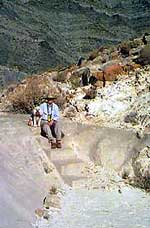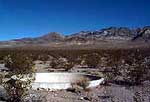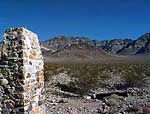CARRARA, NEVADA— A discovery of an outcropping of snow-white marble in the mountains southeast of the gold town of Rhyolite, Nevada, near Death Valley in early 1904 led to the founding of the small community known as Carrara. Peering into the gaping maw of the long-abandoned quarry, one can see some small veins of marble similar to that used by famous sculptors like Michelangelo and quarried from the northern Apennines in Italy. Unfortunately for the investors of the American Carrara Marble Company formed in June 1912, much of the marble found at the site proved to be of insufficient quality to reap a bonanza of wealth. Between 1911 and 1913 the Company laid out a townsite that featured a town fountain, hotel and store. Water for the town and for the milling operation was piped in from nearby Gold Center and " The Carrara Pacific," a three-mile Lidger cable tram system, was built to tie in with the Las Vegas & Tonopah Railroad. This tram used the weight of full cars coming down the hill to pull empty rail cars up the hill. There was a wide section at the halfway point of the track that allowed the cars headed up the hill to pass those on the downward path. It operated much like a pendulum on a cuckoo clock. On April 7, 1914, the first slabs of marble were shipped from the quarry. After the LV & T railroad ceased operating in1917, a spur from the Tonopah and Tidewater Railroad, owned by the Pacific Coast Borax (of Twenty Mule Team fame) was built to accommodate shipping from The Carrara Pacific. During Carrara's heyday, it boasted a town of nearly 100 residents, with its own newspaper and post office. By September 1919 the marble was determined to be too fractured to be profitable and the quarry was closed. Most of the remaining population was gone by 1924.
(Research thanks to: David Wright, Great Basin Research; Mark Holloway, Beatty, NV; Alan Baltazar) Mark |


 Mark &
Mark &  Carrara's town fountain
Carrara's town fountain Today,
much of this ghost town has been reclaimed by the desert, but
it is still possible to find the empty town fountain, septic seepage
pits, a community stone fireplace and some rock wall foundations
of the old hotel and some of the outbuildings. The road to the quarry
follows the path of the old Carrara Pacific tram and is very steep.
Mark Holloway cheerfully transported Megan, Marvin, and me in his
four-wheel drive pickup (350,000 miles and still going strong!)
to the site of the old quarry. The remaining exposed marble is reminiscent
of a Greek temple and a majestic spot to sit and view the striking
desert scenery. Despite the presence of the quarry it seems like
the land has changed little since the time of the "Clovis People,"
ancestors of the Shoshone, Paiute and Kawaiisu people who lived
in the area as far back as eleven thousand years ago.
Today,
much of this ghost town has been reclaimed by the desert, but
it is still possible to find the empty town fountain, septic seepage
pits, a community stone fireplace and some rock wall foundations
of the old hotel and some of the outbuildings. The road to the quarry
follows the path of the old Carrara Pacific tram and is very steep.
Mark Holloway cheerfully transported Megan, Marvin, and me in his
four-wheel drive pickup (350,000 miles and still going strong!)
to the site of the old quarry. The remaining exposed marble is reminiscent
of a Greek temple and a majestic spot to sit and view the striking
desert scenery. Despite the presence of the quarry it seems like
the land has changed little since the time of the "Clovis People,"
ancestors of the Shoshone, Paiute and Kawaiisu people who lived
in the area as far back as eleven thousand years ago. The
turnoff for Carrara is located at Nye County mile
marker 51 on US 95. The foundations for the mill are
near the turnoff, and the townsite is about three
hundred yards to the northeast. Some cement structures
about a mile north of Carrara are the remains of the
abandoned Elizalde Cement Company plant that was built
in the early 1930's.
The
turnoff for Carrara is located at Nye County mile
marker 51 on US 95. The foundations for the mill are
near the turnoff, and the townsite is about three
hundred yards to the northeast. Some cement structures
about a mile north of Carrara are the remains of the
abandoned Elizalde Cement Company plant that was built
in the early 1930's.